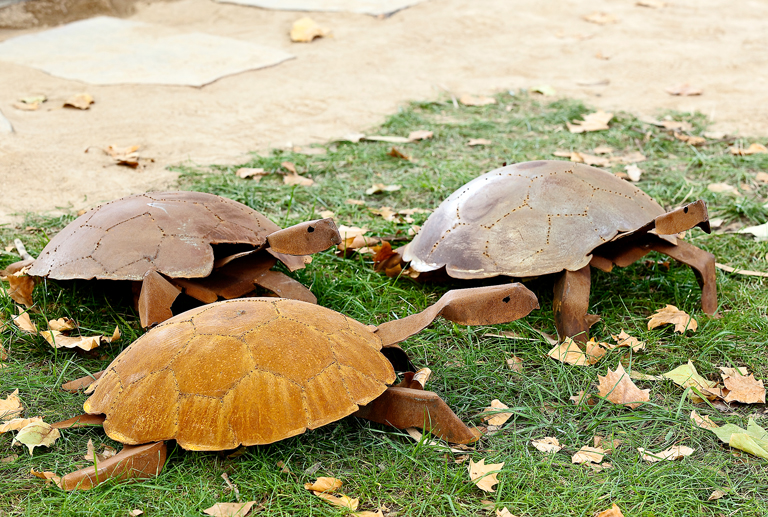
Outdoor Gallery
Jim Fogarty says beautiful sculpture and other garden art can bring personality and story-telling to your garden design, making the whole design itself a work of art.
Garden designers who utilise vistas will inevitably also incorporate some sort of sculpture as a focal point and, as a result, sculpture has become a popular form of modern-day story telling and garden art.
In cool climate, deciduous winter gardens, sculpture can provide great interest when all else is bare. You could use it as a focal point, or take the other tack and place the sculpture discreetly along a path or hidden slightly by foliage.
Sometimes you may want to locate sculpture on centre stage for all and sundry to enjoy, but depending on the mood you want to create, it can be just as rewarding to allow visitors to discover the sculpture within a garden.
Drawcards
A well-placed sculptural piece can draw people into the garden. Controlling and encouraging movement is an important aspect of garden design, especially in larger gardens. Focal points and sculpture can be connected by primary views to direct movement as people wander through a garden. Sculpture in this form can also help to tell a story, which might connect with the garden, the landscape, or even a story about the garden’s owner.
Pausing to think
Sculpture’s ability to provoke thought allows people to enjoy a garden in a contemplative way, so incorporate somewhere for the visitors to sit to view the piece in comfort and peace. Doing this slows people down in a garden and lets them take in the whole picture, plants, art and all.
Materials options
The choice of the sculpture itself is, of course, a very personal one. Sometimes it is made by the garden designer, othertimes the owner or quite often a combination of both. There are endless materials a sculpture can be made from, such as bronze, steel (in its many forms), timber, clay, concrete, fibreglass, stone, or a blend of different materials. As well as the material itself, colour and texture are equally important, as sculpture needs to work with the garden and the mood you want to create.
Blend or contrast?
A piece of garden sculpture can either blend into the existing scheme or, for a modern impact, may contrast entirely with the other materials and colours there. Contrasting is the risky option, as the sculpture tends to sit out on its own and is presented for the viewer to critique in all its glory. If you want garden art that sits within the landscape, choose materials that are harmonious with other materials in your garden. Remember, though, that once the garden is planted, the sculpture becomes part of the landscape rather than becoming a potential eyesore.
Plantings
Blending plants with sculpture can create a strong impact and is a good way to connect sculpture to a garden. It might be the materials used for the sculpture that connect with a plant, or a colour that picks up on a flower colour. For instance, a piece of garden art made from bamboo would work well sitting amid a grove of bamboo. Trees can be used effectively to shroud a sculpture so it doesn’t sit in full sun. Large shrubs and groundcovers can help frame the sculpture so that it sits naturally amongst foliage. Think about how you will use a piece of sculpture in your garden so that you can plan the right plants to complement it.
Reflections
Using water as a way of creating a calming atmosphere can work very harmoniously with sculpture, but the greatest attribute water can provide is reflection. Installing a pond or water feature might be beyond the space constraints and budget of many gardeners, but if you have a swimming pool, think about placing the sculpture to create the same reflective effect, especially at night.
Lighting
At night, the mood of any garden changes considerably and under light, the impact and effect of a sculptural piece can be manipulated with lighting effects. This way, sculpture that during the day might seem discreet can stand out at night under targeted light. Alternatively, a daytime feature might be hidden in darkness at night. The exciting new ranges of coloured LED outdoor lights offer even more options for adventurous designers.
Local talent
Often the best sculpture to use in your garden is one created by a local artist. This is what will make your garden unique to visitors from interstate or overseas. Artwork in the garden should tell a story, whether it is about the location of your garden, or even a story about yourself and your garden. Using local sculpture will make your garden more relevant to the local environment, but it also supports artists in your local community.
Leading names
There are many garden shows held around Australia and this is a great way to spot a local sculptor or piece of work that interests you. Here is a snapshot of some of Australia’s best known artists that specialise in garden art:
Will Wilson: www.williewildlifesculptures.com.au
Lump: www.lump.com.au
Rudi Jass: www.jassdesign.com.au
Aludean Design: www.aludean.com
The Modcollective: www.themodcollective.com.au
Roger Apte: www.eosmanagement.com
Malcolm Abbott: www.formartive.com
Parterre Garden: www.parterre.com.au
Peter Mclisky: www.petermclisky.com.au
Sculptura: www.sculptura.com


